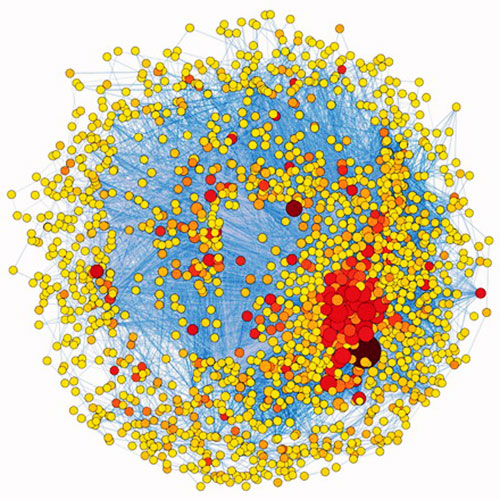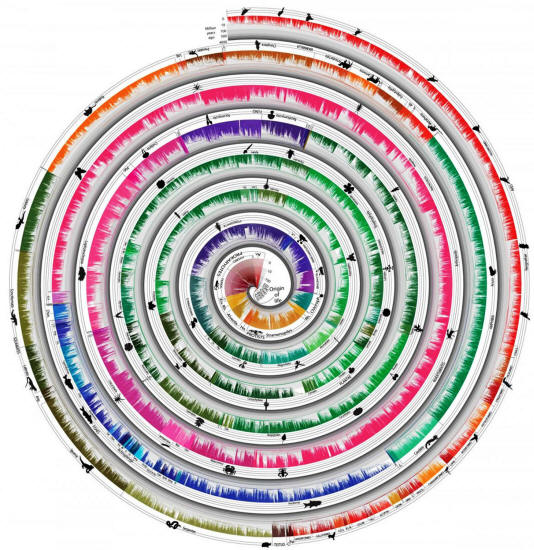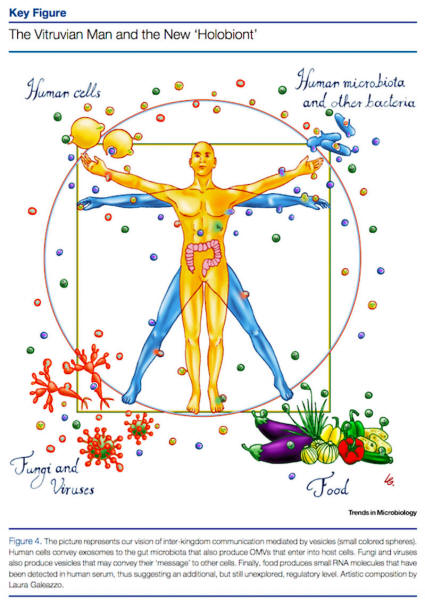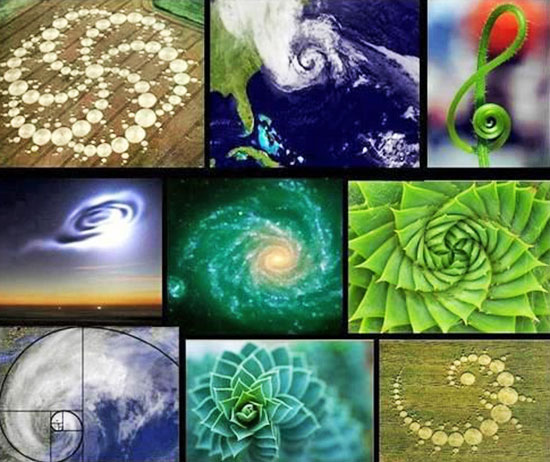|
by Sayer Ji from GreenMedInfo Website
Biological Science has been under the spell of Newton's atomistic view of the universe since the late 17th century.
Yet revolutionary new
discoveries in molecular biology reveal a connectivity and
proportionality embedded within our bodies and the biosphere as a
whole reminiscent of ideas once held by visionaries like
Leonardo
da Vinci.
The view held that in
order to understand life, one must focus on what is believed to be
the indivisible and elementary vital units of the cell, taking an
epistemological decompositional and/or bottom up approach to
understanding more complex processes.
This effort could be considered to have ran aground in 2003 with the completion of the human genome project, which failed to produce sufficient complexity and information in the ~23,000 protein-coding genes discovered to adequately account for the extremely complex interrelationships and behaviors of the 100,000+ proteins in the human body.
For example, an earthworm has more protein-coding genes than a human.
Also, if you consider that each second each human cell undergoes approximately 100,000 biochemical operations, the information contained within the protein-coding sequences of the human genome are vastly inadequate to explain the extraordinary feats biological phenomena articulate,
In a nutshell, there is absolutely no way that the 23,000 protein coding genes contain the information needed to explain how the proteins within cells function.
You also have the work of Rupert Sheldrake, PhD, who has proposed the existence of morphogenetic fields, which inform and coordinate the behavior of biological structures, but are not reducible to those structures themselves, and which have non-local effects not unlike what one observes in quantum physics (The Science Delusion).
And the work of Jack
Kruse, MD, who explains how the cellular
bioenergetics of the cell take
advantage of a literal lightning bolt of energy contained within the
magnetic field strength of the mitochondria within our bodies, and
which make possible amazing feats of energy and material
manifestation, proving the cells have at their disposal, abilities
which classical physics and biology consider impossible due to the
their deference to the
Second law of thermodynamics which
biological structures violate 24/7...
This phenomena is also
known as
inter-kingdom communication, as
it involves cross-talk and information sharing between bacteria
and archaea (both prokaryotes), and plants and
animals (both eukaryotes) such as ourselves - something which
classical genetics and evolutionary theory did not believe was
possible until recently.
If plants communicate with animals, fungi with bacteria, and so on and so forth, these hermetically sealed off compartments dissolve, perhaps looking more like an open-ended spiral as depicted on the left below.
The implications of this
paradigm shift are truly revolutionary and speak to a radical holism
in life that hitherto was only discussed on the fringes of
mainstream science.
For instance, bacteria in our gut produce these microRNA containing nanovesicles (about the size of a virus) called outer-membrane vesicles (OMV), which communicate with the cells of our body in a significantly correlated and coordinated way.
For instance, the gene expression of our intestinal cells is generally coordinated to our gut microbiota composition. The relationship is bilateral, as there is 'cross talk' between intestinal cells secreting miRNAs and the bacteria that are affected by them, and vice versa.
Emerging concepts like
the gut-brain axis speak to this interconnectivity mediated by
bacterial OMVs and human
exosomes, both of which carry and deliver
microRNas
In other words, our genome is not only deeply affected by the microbiome via microRNAs and 'cross talk' between them, but food itself forms an essential part of this structure, connecting us in our species definition to the entire biosphere via all the plants, animals, fungi that we use as food.
As previously discussed, food contains miRNAs that are packaged in microvesicles known as exosomes, and which have been found to survive digestion and cooking, enter into systemic circulation within us, and affect gene expression.
The implications of this are revolutionary insofar as we can start to understand that food is more than just medicine, but that essential governing part of our our health that also provides genetic and epigenomic stability to our species.
That's one reason why the absence of certain foods in our diet have at least as much to do with information deficiency as it does mineral and nutrient deficiency, and why we have focused on spreading awareness on the fact that food is a source of gene-regulatory information before anything else.
This also means that
GMO foods can dramatically alter
(and disrupt) our gene expression in a way that risk assessments
presently do not explore.
Consider the traditional holobiont concept which introduced the radical idea that humans are "ecological units," and are best defined as being comprised of all the species which inhabit it, including the viruses, bacteria, archaea, fungi, and even other animals like helminths, as part of its microbiome.
But this view did not
include vegetal or animal contributions of microRNAs, represented by
our food.
As you can see, because of the interconnectivity and "social networking" functionalities of RNAs packaged in microvesicles called exosomes, all four parts of this new definition of man become united in an indivisible whole.
Because these RNAs packed in edible exosomes epigenetically active, the food we eat,
This is a truly revolutionary departure from previous concepts of what makes up the human.
The addition of food to the human holobiont, while blurring lines between what is truly self and other, also connects us to the biosphere in an unprecedented way.
Because most of the public still considers it simply a source of energy and building blocks for their 'body machines.'
In this new model, not only is it a source of information, but it has regulatory capacity on gene expression, not that different or less significant than the other components.
Given that they carry
actual regulatory nucleic acids like miRNAs, which are known to
target the expression of ~60% of the human genome, foods may be as
essential to our genomic and epigenomic stability as our genes
themselves.
The image depicts a man inscribed in a circle and square in two superimposed positions with his legs and arms apart.
Vitruvian literally translates to,
Vitruvius (80-70 BC to 15 BC)
was a Roman architect who considered the human body the principal
source of proportions among classical architecture.
Encyclopædia Britannica online states,
The concept that the body, along with many other natural phenomena, contains proportions and geometries found in the universe as a whole is already established in Fibonacci series (a series of numbers in which each number ( Fibonacci number ) is the sum of the two preceding numbers.
The simplest is the series 1, 1, 2, 3, 5, 8, etc., also known as the golden ratio.
From fingers to faces,
flower petals to seed heads, pine cones to galaxies, the pattern is
the same.
Previous to the discovery that there is horizontal gene transfer and reversibility of information flow in cells from the outside in (environment > nucleus), the reductionist view of biological atomism precluded there being a mechanism to connect the part to the whole.
Now we see that the kingdoms of life are no longer hermetically sealed off in endless competition with one another. They participate with and in one another, in a type of network which speaks to the oneness and openness of life as a whole.
A compelling paper
published in 2015 in Medical Hypothesis suggests, among other
things, the existence of a plausible molecular mechanism to account
for a hitherto inexplicable aspect of the so-called Gaia
hypothesis, a theory which proposes that the Earth as a whole
(both biotic and abiotic aspects) is self-regulating and controlled
by the community of living organisms.
...identifies transcribable elements within the so-called "dark matter" of the genome (the about 98.5% of the genome that does not code for proteins) known as non-coding RNAs.
One kind of non-coding
RNA identified in the study known as microRNA is believed capable of
acting as a master regulator of gene expression across kingdoms.
If MicroRNAs indeed function as cross-kingdom master regulators of the divers members of the biosphere, every living thing is therefore inseparably connected via interpenetrating webs of genetic and epigenetic relationships.
This perspective
radically diverges from classical evolutionary theory where
organisms are viewed externally related to one another, with
self-preservation and survival - not co-operation - as its primary
organizing principle.
|







